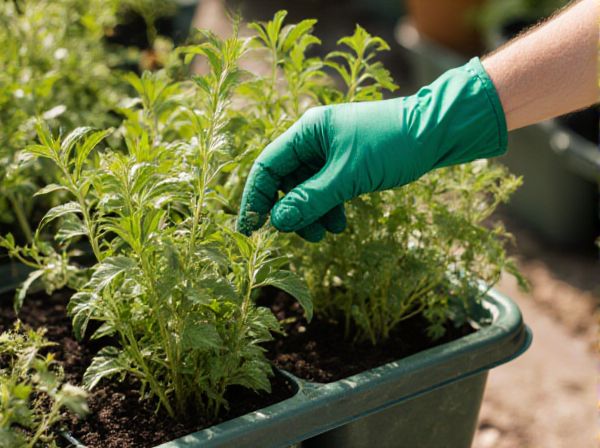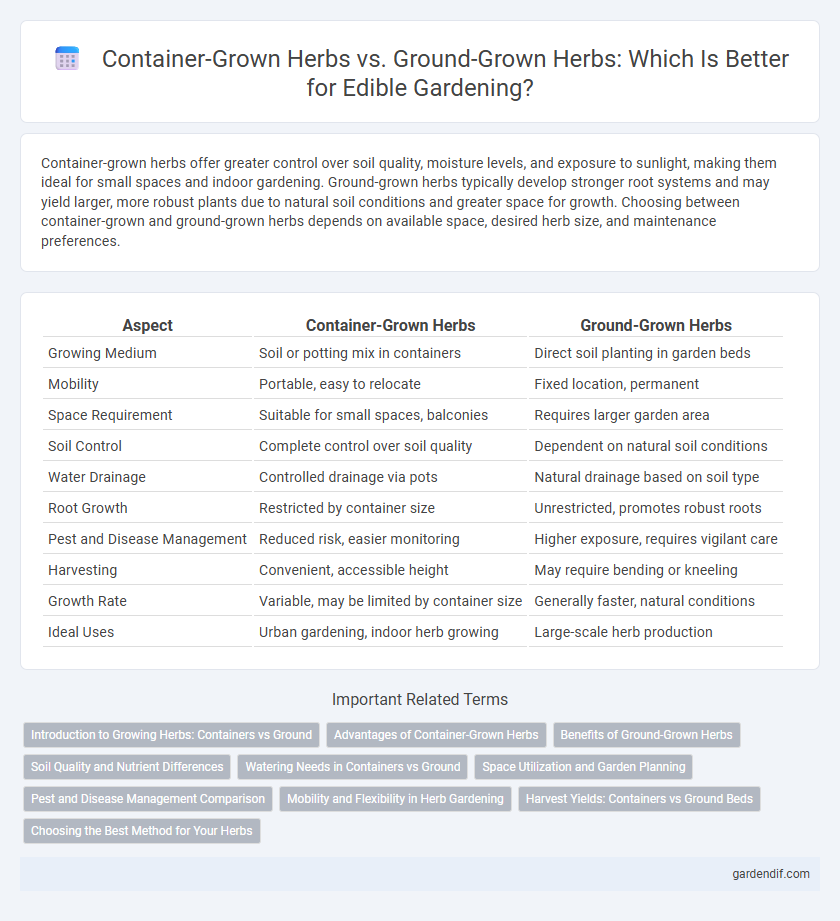
Container-grown herbs vs ground-grown herbs Illustration
Container-grown herbs offer greater control over soil quality, moisture levels, and exposure to sunlight, making them ideal for small spaces and indoor gardening. Ground-grown herbs typically develop stronger root systems and may yield larger, more robust plants due to natural soil conditions and greater space for growth. Choosing between container-grown and ground-grown herbs depends on available space, desired herb size, and maintenance preferences.
Table of Comparison
| Aspect | Container-Grown Herbs | Ground-Grown Herbs |
|---|---|---|
| Growing Medium | Soil or potting mix in containers | Direct soil planting in garden beds |
| Mobility | Portable, easy to relocate | Fixed location, permanent |
| Space Requirement | Suitable for small spaces, balconies | Requires larger garden area |
| Soil Control | Complete control over soil quality | Dependent on natural soil conditions |
| Water Drainage | Controlled drainage via pots | Natural drainage based on soil type |
| Root Growth | Restricted by container size | Unrestricted, promotes robust roots |
| Pest and Disease Management | Reduced risk, easier monitoring | Higher exposure, requires vigilant care |
| Harvesting | Convenient, accessible height | May require bending or kneeling |
| Growth Rate | Variable, may be limited by container size | Generally faster, natural conditions |
| Ideal Uses | Urban gardening, indoor herb growing | Large-scale herb production |
Introduction to Growing Herbs: Containers vs Ground
Container-grown herbs offer precise control over soil quality, moisture levels, and sunlight exposure, making them ideal for small spaces and urban gardening. Ground-grown herbs typically develop stronger root systems and can yield larger, more robust plants due to unrestricted soil access and natural ecosystems. Choosing between container and ground cultivation depends on available space, climate conditions, and desired herb varieties.
Advantages of Container-Grown Herbs
Container-grown herbs offer superior control over soil quality, moisture levels, and sunlight exposure, resulting in healthier, more flavorful plants. They reduce the risk of soil-borne diseases and pests, enhancing plant longevity and yield. Portability allows gardeners to optimize growing conditions seasonally or relocate the herbs to ideal microclimates, improving overall growth and harvest.
Benefits of Ground-Grown Herbs
Ground-grown herbs benefit from natural soil nutrients and microbial activity, promoting robust growth and richer flavor profiles compared to container-grown varieties. These herbs often develop deeper root systems, enhancing drought tolerance and overall plant health. Cultivating herbs directly in the ground reduces the need for frequent watering and repotting, contributing to more sustainable and cost-effective gardening.
Soil Quality and Nutrient Differences
Container-grown herbs often rely on controlled potting mixes that provide consistent soil quality and tailored nutrient levels, optimizing growth and flavor concentration. Ground-grown herbs benefit from natural soil ecosystems rich in organic matter and microbial activity, contributing to complex nutrient availability but with greater variability. Soil quality in containers can be precisely managed to prevent nutrient deficiencies common in some ground soils, directly influencing the herb's vitality and taste profile.
Watering Needs in Containers vs Ground
Container-grown herbs require more frequent watering than ground-grown herbs due to limited soil volume and faster drying. Ground-grown herbs benefit from deeper soil that retains moisture longer, reducing irrigation frequency. Proper drainage in containers is essential to prevent root rot, while ground herbs rely on natural soil absorption.
Space Utilization and Garden Planning
Container-grown herbs optimize space by allowing vertical stacking and mobility, ideal for small balconies or patios. Ground-grown herbs benefit from larger, natural root zones, which can enhance growth but require more extensive garden planning and dedicated ground space. Efficient garden planning balances these methods to maximize herb variety and yield within available space.
Pest and Disease Management Comparison
Container-grown herbs offer greater control over pest and disease management by isolating plants, reducing exposure to soil-borne pathogens and enabling targeted treatments. Ground-grown herbs are more susceptible to infestations such as aphids, spider mites, and fungal diseases due to direct soil contact and larger planting areas. Regular monitoring, proper sanitation, and use of organic pest control methods remain crucial for both cultivation methods to maintain healthy herb growth.
Mobility and Flexibility in Herb Gardening
Container-grown herbs offer superior mobility and flexibility, allowing gardeners to easily relocate plants for optimal sunlight, temperature, and space management. These containers enable seasonal adjustments and protection from harsh weather, making them ideal for urban or small-space gardening. Ground-grown herbs, while benefiting from natural soil conditions, lack this adaptability and remain fixed in place, limiting dynamic garden design and microclimate management.
Harvest Yields: Containers vs Ground Beds
Container-grown herbs typically yield smaller harvests due to restricted root space and limited soil nutrients compared to ground-grown herbs. Ground beds provide a more extensive root system and access to natural soil ecosystems, resulting in higher biomass and more robust herb growth. Optimizing soil quality and container size can partly mitigate yield differences, but ground cultivation generally offers superior harvest volumes.
Choosing the Best Method for Your Herbs
Container-grown herbs offer flexibility in controlling soil quality, moisture, and sunlight exposure, ideal for small spaces or indoor gardening. Ground-grown herbs benefit from natural soil nutrients and extensive root development, resulting in more robust growth and higher yield when space permits. Selecting the best method depends on available space, climate conditions, and the specific herb's growth requirements.
Container-grown herbs vs ground-grown herbs Infographic

 gardendif.com
gardendif.com